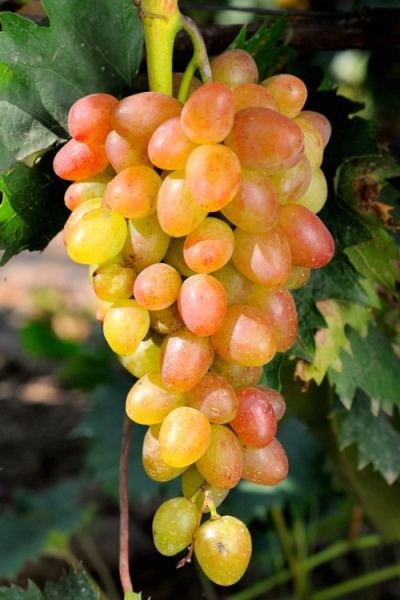
- Authors: Kapelyushny V.U.
- Appointment: dining room
- Berry color: pink
- Taste: harmonious, aromatic, with a touch of nutmeg
- Ripening period: very early
- Ripening period, days: 100-110
- Frost resistance, ° C: -25
- Name synonyms: 1-13-34
- Bunch weight, g: 600-900
- Flower type: bisexual
There are very early table grape varieties, although there are not many. The Crimson Grape belongs to just such. In this article, we will consider the characteristics of the variety, yield, ripening times, as well as storage.
Breeding history
The Crimson grape was bred by an amateur breeder V. Kapelyushny. For the parental pair, the Voskovoi and Charrel grape varieties were selected. The main task when breeding a new hybrid was to make the plant tolerate frost well and have a high yield.
The Crimson grape is also listed by the name 1-13-34.
Description
The variety belongs to very early maturing crops. The ripening period of the fruit takes no more than 100 days.
The bushes are vigorous, up to 3 m long. The peak of full growth of the bushes occurs in the third year after planting in the ground. The vine is strong, brownish in color.
Leaves with 3 lobes; there is a characteristic section in the middle of the leaf. Ribbing and slight pubescence are present along the edging.
Ripening period
Flowering occurs in early May, and after 90-100 days it will be possible to harvest the first crop. If the cultivation takes place in the north-western regions, where the summers are short and rather cool, then the ripening period increases, and the first fruits appear in early September.
Bunches
The bunches are strong, well adhered to the stem. On one brush, 100 berries can ripen at once. The weight of one bunch is 600-900 g. 2-3 clusters without peas ripen well on one vine. More bunches on the vine will crush the berries.
Berries
The berries are large and large. They are nipple-shaped in shape with an elongated and rounded end. Shades range from pink to light purple. By weight, the fruits can be from 12 to 14 g. The pulp is juicy, transparent and fleshy. The seeds are well separated from the pulp. The skin is thin, does not burst under mechanical stress.
Taste
The taste of the grapes is sweet, harmonious with subtle notes of nutmeg. The amount of sugar is 210 g / dm3 per 6 g / dm3 of acidity. Many gardeners note that these indicators can change depending on the place of cultivation.
Yield
Productivity from one bush is 7 kg. It happens that the indicators vary, and up to 15 kg can be removed from one bush.


Growing features
Crimson grapes are an unpretentious variety, therefore, you do not need to observe any special agrotechnical points. In order for the yield to be high, you just need to follow several stages of cultivation:
garter vines;
timely pruning;
top dressing;
watering.
Landing
Grapes love loose soil, equipped with minerals, so before planting it is necessary to dig up the selected area. Before planting seedlings in the ground, it is necessary to inspect the root system - it must be well developed, have from 2 root buds and 2-3 shoots.
Holes must be dug 0.8 m deep and 0.5-0.8 in diameter.Since the grapes do not like excessive moisture, drainage is laid out at the bottom of the hole, for example, from broken bricks. The drainage is covered with soft earth with a small hill, and only after that the seedling is planted. It is necessary to compact the ground around the vine so that the grapes do not bend over in the future. Spill the soil with one bucket of warm water.
The distance between the bushes should be 2-2.5 m, and between the rows 3 m.

Pollination
Flowers in Crimson grapes of both sexes, pollination is uniform, so additional pollination is not required.
Pruning
Pruning of grapes takes place in several stages.
Spring pruning is carried out after the snow melts, when the air temperature warms up above +5 degrees. Remove damaged and broken shoots.
Summer pruning is necessary in order to remove excess shoots, branches that do not bear fruit. And also the leaves at the bottom of the vines and those that cover the bunches too much are cut off.
Autumn pruning is done after the vine has removed all the leaves. It is necessary to remove excess shoots, those that have borne fruit for more than 3 years and those that have been susceptible to disease or pests.



Frost resistance and the need for shelter
Frost resistance of this variety is high up to -25 degrees. Therefore, in the southern and central regions, coverings are not necessary. But in the northern latitudes, where the temperature drops below -25, or sudden temperature changes are possible, it is worth covering all the vines with agrofibre.

Diseases and pests
This hybrid tolerates a number of diseases well, it is not afraid of oidium and mildew. But still, in order to avoid fungal diseases, grapes should be sprayed, as they can get sick with gray rot.
The main pests of Crimson grapes are bees. Bees really like the taste of grapes, and because of them, the berries lose almost all their juiciness and begin to deteriorate. In order to secure the harvest, it is worth using liquid smoke.

If a grape is exposed to any disease or insect, this always affects its appearance.
Storage
The grapes have good transport performance. But if you do not follow the storage rules, then this culture begins to deteriorate quickly.
In a cool and dry place, grapes can be stored for 2-3 weeks.











































































